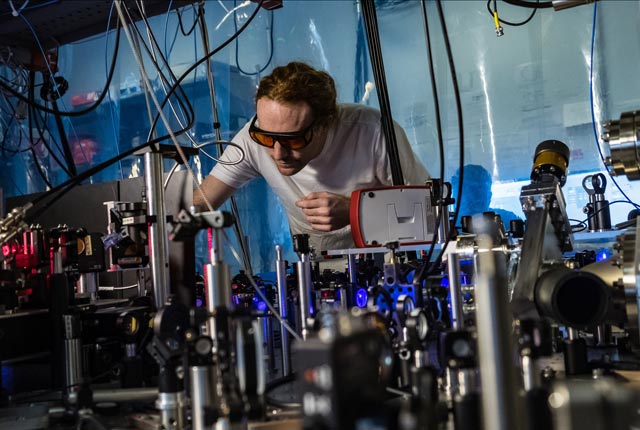HOUSTON — (Feb. 28, 2018) — Using lasers, U.S. and Austrian physicists have coaxed ultracold strontium atoms into complex structures unlike any previously seen in nature.
“I am amazed that we’ve discovered a new way that atoms assemble,” said Rice University physicist Tom Killian. “It shows how rich the laws of physics and chemistry can be.” Killian is the lead scientist on a new paper in Physical Review Letters (PRL) that summarized the group’s experimental findings.
Killian teamed with experimental physicists from Rice’s Center for Quantum Materials and theoretical physicists from Harvard University and Vienna University of Technology on the two-year project to create “Rydberg polarons” out of strontium atoms that were at least 1 million times colder than deep space.
The team’s findings, which are summarized in the PRL paper and a companion theoretical study appearing this week in Physical Review A (PRA), reveal something new about the basic nature of matter, Killian said.
“The basic laws that we learn in chemistry class tell us how atoms bond together to form molecules, and a deep understanding of those principles is what allows chemists and engineers to make the materials we use in our everyday lives,” he said. “But those laws are also quite rigid. Only certain combinations of atoms will form stable bonds in a molecule. Our work explored a new type of molecule that isn’t described by any of the traditional rules for binding atoms together.”
Killian said the new molecules are only stable at extraordinarily cold temperatures — about a millionth of a degree above absolute zero. At such low temperatures, the constituent atoms stay still long enough to become “glued together” in new, complex structures, he said.
“One amazing thing is that you can keep attaching an arbitrary number of atoms to these molecules,” Killian said. “It’s just like attaching Lego blocks, which you can’t do with traditional types of molecules.”
He said the discovery will be of interest to theoretical chemists, condensed matter physicists, atomic physicists and physicists who are studying Rydberg atoms for potential use in quantum computers.
“Nature takes advantage of a fascinating toolbox of tricks for binding atoms together to make molecules and materials,” Killian said. “As we discover and understand these tricks, we satisfy our innate curiosity about the world we live in, and it can often lead to practical advances like new therapeutic drugs or light-harvesting solar cells. It is too early to tell if any practical applications will come from our work, but basic research like this is what it takes to find tomorrow’s great breakthroughs.”
The team’s efforts centered around making, measuring and predicting the behavior of a specific state of matter called a Rydberg polaron, a combination of two distinct phenomena, Rydberg atoms and polarons.
In Rydberg atoms, one or more electrons are excited with a precise amount of energy so that they orbit far from the atom’s nucleus. Rydberg atoms can be described with simple rules written down more than a century ago by Swedish physicist Johannes Rydberg. They have been studied in laboratories for decades and are believed to exist in cold reaches of deep space. The Rydberg atoms in the PRL study were up to one micron wide, about 1,000 times larger than normal strontium atoms.
Polarons are created when a single particle interacts strongly with its environment and causes nearby electrons, ions or atoms to rearrange themselves and form a sort of coating that the particle carries with it. The polaron itself is a collective — a unified object known as a quasiparticle — that incorporates properties of the original particle and its environment.
Rydberg polarons are a new class of polarons in which the high-energy, far-orbiting electron gathers hundreds of atoms within its orbit as it moves through a dense, ultracold cloud. In the Rice experiments, researchers began by creating a supercooled cloud of several hundred thousand strontium atoms. By coordinating the timing of laser pulses with changes in the electric field, the researchers were able to create and count Rydberg polarons one by one, ultimately forming millions of them for their study.
While Rydberg polarons had previously been created with rubidium, the use of strontium allowed the physicists to more clearly resolve the energy of the coated Rydberg atoms in a way that revealed previously unseen universal characteristics.
“I give a lot of credit to the theorists,” said Killian, a professor of physics and astronomy. “They developed powerful techniques to calculate the structure of hundreds of interacting particles in order to interpret our results and identify the signatures of the Rydberg polarons.
“From an experimental standpoint, it was challenging to make and measure these polarons,” he said. “Each one lived for only a few microseconds before collisions with other particles tore it apart. We had to use very sensitive techniques to count these fragile and fleeting objects.”
Study co-authors include Joe Whalen, Roger Ding and Barry Dunning, all of Rice; Francisco Camargo, formerly of Rice and now of AMD; Germano Woehl Jr., formerly of Rice and now of the University of the São Paulo; Shuhei Yoshida and Joachim Burgdörfer of Vienna University of Technology; Hossein Sadeghpour of the Harvard-Smithsonian Center for Astrophysics; and Richard Schmidt and Eugene Demler of Harvard University.
The research was supported by the Air Force Office of Scientific Research, the National Science Foundation, the Robert A. Welch Foundation, the Austrian Science Fund, the Army Research Office, Dr. Max Rössler, the Walter Haefner Foundation and the ETH Foundation.















